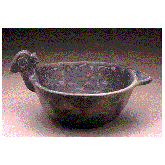Curriculum Materials: Art in America
|
|
 |
Introduction to Art in America
Diverse cultural groups and individuals have contributed to the rich history of art in America. Throughout the lands that now constitute the United States, native peoples established vital art traditions centuries before Europeans arrived. Over the last three centuries, people have come to America from many nations, bringing their own artistic heritages with them. As these diverse cultures came into contact with one another and exchanged creative ideas, new art styles developed.
What then is American art? While this question has no single answer, it is possible to explore many of the threads that contribute to the rich tapestry of American art. By studying art made in America, we can also learn a great deal about the experiences that make up our shared history. The artworks in this presentation, dating from the 12th to the 20th century, tell us about America's history-its lands, people, and daily experiences.
The vast and varied landscape of America has meant many things to the people who live here. A clay effigy bowl by a Caddo Indian exemplifies the earliest Americans' respect for the land as a valuable resource. The expansive Catskill Mountain landscape by Jasper Cropsey or the site of Fort Snelling as recorded by Edward K. Thomas convey an experience of the wilderness as well as of the development that transformed the American landscape. George Morrison's large abstract collage, created from pieces of wood of varying sizes, textures, and colors, represents a more recent response to the American land.
America's population is as varied as its landscape, and artists play an important role in recording that diversity. Their visual records introduce us to U.S. farm and factory workers, musicians, and a vast array of others who have contributed to America's history. Mrs. Allen's formal portrait, painted by John Singleton Copley in the 18th century, typifies portraits commissioned by wealthy colonial Americans who prized realistic likenesses but who also desired to associate themselves with English aristocracy through traditional poses and studio props. The introduction of photography revolutionized the representation of America's people, as shown in Alfred Stieglitz's photo of immigrants returning to their homelands in 1907, or in James Van DerZee's portrait of a couple during Harlem's cultural renaissance.
Works of art that portray the activities of people provide insight into American ways of life. Cadzi Cody's painted elk hide shows parts of a Shoshone bison hunt and sun dance, and Clementine Hunter's colorful painting shows southern plantation workers doing the wash. The modest furnishings of an 18th-century parlor from a farmhouse in Foxon, Connecticut, reveal that the same room functioned both as the main parlor, where guests were received, and as the master bedroom. Robert Koehler's painting of a rainy evening on Hennepin Avenue in 1902 provides a glimpse not only of the fashions of the day, but also of such modern conveniences as the sidewalk and electric streetcar. The sewn hide, colorful beaded design, and hand-crafted bells of the Lakota woman's dance dress provide information about Lakota traditions and lifestyle.
Like any collection of images, the images presented here
tell only part of the story. Historically, art museums have
collected art primarily from western European societies,
while natural history and anthropological museums have
collected "cultural artifacts," which are in their own right
creative works of art. The distinctions between art and
artifact are now being broken down, however, and museums
throughout the United States, including The Minneapolis
Institute of Arts, are expanding their collections
accordingly. Because the Institute's current collection of
American art reflects the earlier philosophy and is,
therefore, decidedly slanted toward European-American art,
so is presentation. As the collection grows, artworks will
be added to reflect more fully America's diversity.
|
|